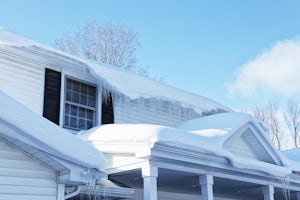
Canadian winters may see several freeze-thaw periods, which can cause water damage to your home through various points of entry, including your roof. In particular, homeowners should be mindful of potential roof damage that is caused by ice damming or snow load.
What is ice damming?
Ice damming occurs when ice and water accumulate on your roof due to melting snow, changing temperatures, and improper ventilation. As heat rises in your attic, ice will melt with the increased temperature and refreeze when the temperature drops. As a result of this combination, water can start to build within the eavestroughs and under roof shingles. If the water has nowhere else to drain, it can enter from the roof into your home through the insulation and walls, causing water damage and even mould.
What is snow load?
Snow load is the pressure put on a roof from the weight of snow, water, or ice. This can cause structural damage to your roof such as a collapse or leaks.
Below are some tips to save your roof from ice damming and snow load.
Inspect outside
- Be sure to remove any ice or snow from your eavestroughs so water can flow freely (for example, use a broom to safely knock down any icicles hanging from the gutters).
- Reposition any downspouts away from the house and check to ensure they are free of debris.
- If you wish to remove snow from your roof, do so safely. Do not climb directly on the roof or use a rake to remove snow as this can damage your roof. Consider hiring a professional to clear snow and ice safely.
- If the extent of ice damming is significant, consider contacting a professional roofer or gutter cleaning expert.
Look inside
- Check your roof from inside your home via the attic to ensure water is not entering.
- Check the insulation in your attic to ensure it has been properly maintained. For example, is there enough insulation? Are weather stripping and seals properly installed?
- Roof ventilation is extremely important and a well-maintained temperature can help eliminate the contribution to the freeze-thaw and accumulation of water. If you are unsure of your roof ventilation, consult a professional to inspect and advise.
- As a reminder with any valuables or important items stored in your basement or attic, be sure to place them in plastic containers stored off the floor.
Through a few simple precautionary steps, you can prevent this type of winter water damage to your home. Find out more ways you can protect your home from water damage. For questions on your insurance coverage, be sure to speak an insurance advisor in your local BrokerLink branch.